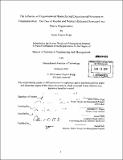The influence of organizational hierarchy and departmental structure on communication : the case of Kaplan and Norton's Balanced scorecard in a matrix organization
Author(s)
Kopp, James Clayton; Kaplan, Robert S
DownloadFull printable version (11.71Mb)
Other Contributors
System Design and Management Program.
Advisor
Christopher L. Magee.
Terms of use
Metadata
Show full item recordAbstract
A large business requires efficient and effective internal communication among employees to achieve its goals. Dodds, Watts, and Sable (DWS) introduced a communication network model assessing information flow within a business by examining the relative influences of organizational structure, message volatility, and task decomposability on the probability of successful message transmission, but there is no research available that examines this or similar models in the context of a real business. The model predicts optimal message flow in a "Multi-scale" organizational network, a structure which in practice may most resemble a matrix organization. In this study a survey was designed to measure the influence of rank and department on message transfer - particularly the informational attributes of understanding, accuracy, importance, and influenceability - originating from the Balanced Scorecard in a large, matrix-managed aerospace business. The survey data indicated the following results: - Understanding (of the Balanced Scorecard metrics) was significantly influenced by employee rank and exhibited some effects of departmental expertise with certain metrics. - Belief in the accuracy of the metrics correlated highly with Understanding. - Importance rankings of the metric displayed high alignment across both rank and department, an encouraging result for company management. - Influenceability (people's belief they could affect the metric) was heavily influenced by rank and somewhat influenced by department. It also generally exhibited the lowest levels and highest variation when compared to the other attributes. - A deeper analysis comparing the Engineering and Program Office departments revealed consistently better vertical communication for Engineering, and better lateral communication within ranks for Program Office, which may indicate an additional influence of department culture on information flow. When subjected to a DWS interpretation, the survey results provided clues about relative influences of rank and department on message flow and relative values of other DWS model parameters - task decomposability and message traffic volume - could be gleaned from employee comments and post-survey interviews. The study falls short of making absolute characterizations of the DWS attributes, but is able to make inferences regarding the communication of the separate attributes relative to each other. Indeed, one important implication of the work done here to DWS theory is that for different business concerns and for different organizations within the overall company, there are apparently different mappings onto the DWS communication framework. Analysis of the study data for this organization indicates lateral communication may be better than vertical communication for Understanding and Influenceability; Accuracy does not exhibit dominance by either parameter; and Importance is well communicated laterally and vertically. More empirical data on measurable information traffic such as email is needed from different organizations, industries, and national cultures for DWS parameter values to converge upon more absolute values.
Description
Thesis (S.M. in System Design and Management)--Massachusetts Institute of Technology, Engineering Systems Division, 2010. Cataloged from PDF version of thesis. Includes bibliographical references (p. 80-81).
Date issued
2010Department
System Design and Management Program.; Massachusetts Institute of Technology. Engineering Systems DivisionPublisher
Massachusetts Institute of Technology
Keywords
Engineering Systems Division., System Design and Management Program.